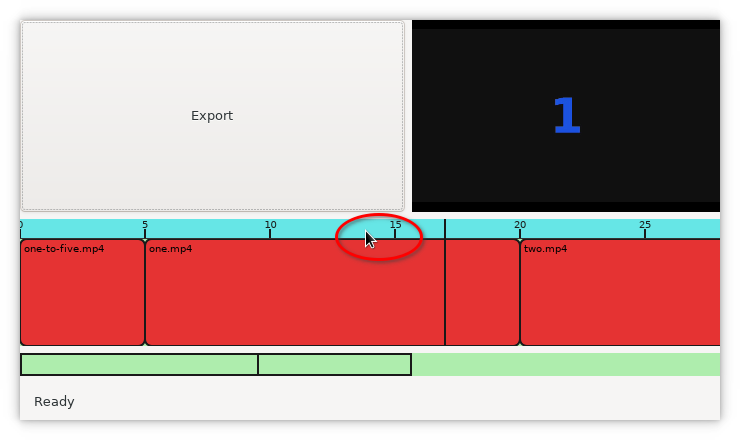DevLog 009: Improve timeline scrubbing
Published on 3 August 2023.
As a try to edit some footage with my video editor, I get annoyed by a timeline scrubbing issue.
Scrubbing the timeline means clicking and dragging the playhead and then the frame at that position will play. This works fine today if you click and drag, but if you only click, nothing happens:

Sometimes I just want to place the playhead at a certain position. And then I just want to click.
That’s what we’ll work on fixing today.
Reviewing the scrub action
Here is the scrub action:
class ScrubAction(Action):
def __init__(self, player, scrollbar):
self.player = player
self.scrollbar = scrollbar
self.mouse_up()
def left_mouse_down(self, x, y):
self.x = x
def mouse_up(self):
self.x = None
def mouse_move(self, x, y):
if self.x is not None:
self.player.scrub(
int(round(
self.scrollbar.content_start
+
x/self.scrollbar.one_length_in_pixels
))
)
We can see that the scrubbing is happening only when we move the mouse, not if we just left click.
The solution seems obvious: make sure to scrub on the click as well.
Let’s see how we can move slowly and carefully and pay attention to design as we go along. Let’s start with a test.
Testing new functionality
This is the test that I come up with:
"""
I scrub the player when clicked:
>>> class MockPlayer:
... def scrub(self, position):
... print(f"scrub {position}")
>>> class MockScrollbar:
... content_start = 0
... one_length_in_pixels = 1
>>> action = ScrubAction(player=MockPlayer(), scrollbar=MockScrollbar())
>>> action.simulate_click(x=10)
scrub 10
"""
The left_mouse_down currently takes both the x and y coordinates. In this test, we only care about the x coordinate. That’s why I introduced Action.simulate_click. The idea is that it should simulate the calls that GTK does when a left click happens. My idea is to extend this further with something like Action.simulate_drag which will fire left_mouse_down, mouse_move, and mouse_up in the same way that GTK would do it.
I implement it like this:
def simulate_click(self, x=0, y=0):
self.left_mouse_down(x=x, y=y)
To make the test pass, I call self.player.scrub in the left_mouse_down event as well. I extract it to a common method to remove the duplication.
This passes the tests, and when I try it in the application, it works as intended.
Are we done?
A concern
Let’s take a moment to think about some design issues.
One thing that worry me is that Action.simulate_click does not actually simulate clicks in the right way. That is, when we hook this up with GTK, the same kinds of events will not be generated.
Let’s have a look at how it works today.
Here is how *_mouse_down is handled:
timeline = Gtk.DrawingArea()
timeline.connect("button-press-event", timeline_button)
timeline.add_events(
timeline.get_events() |
Gdk.EventMask.SCROLL_MASK |
Gdk.EventMask.BUTTON_PRESS_MASK |
Gdk.EventMask.BUTTON_RELEASE_MASK |
Gdk.EventMask.POINTER_MOTION_MASK
)
def timeline_button(widget, event):
# TODO: clarify what translate_coordinates do
if event.button == 1:
self.timeline.left_mouse_down(*timeline.translate_coordinates(
main_window,
event.x,
event.y
))
elif event.button == 3:
self.timeline.right_mouse_down(*timeline.translate_coordinates(
main_window,
event.x,
event.y
), GtkGui(event))
This code exists in a method which has a bunch of other GTK setup code and is quite long.
Let’s see if we can extract a GTK widget that has all the mechanisms for custom drawing and event handling.
I slowly start to extract pieces, and eventually end up with this:
class CustomDrawWidget(Gtk.DrawingArea):
def __init__(self, main_window, custom_draw_handler):
Gtk.DrawingArea.__init__(self)
self.add_events(
self.get_events() |
Gdk.EventMask.SCROLL_MASK |
Gdk.EventMask.BUTTON_PRESS_MASK |
Gdk.EventMask.BUTTON_RELEASE_MASK |
Gdk.EventMask.POINTER_MOTION_MASK
)
self.connect("draw", self.on_draw)
self.connect("button-press-event", self.on_button_press_event)
self.connect("button-release-event", self.on_button_release_event)
self.connect("motion-notify-event", self.on_motion_notify_event)
self.rectangle_map = RectangleMap()
self.custom_draw_handler = custom_draw_handler
self.down_action = None
self.main_window = main_window
def on_draw(self, widget, context):
self.rectangle_map.clear()
self.custom_draw_handler(context, self.rectangle_map)
def on_button_press_event(self, widget, event):
x, y = self.get_coordinates_relative_self(event)
if event.button == 1:
self.down_action = self.rectangle_map.get(x, y, Action())
self.down_action.left_mouse_down(x, y)
elif event.button == 3:
self.down_action = self.rectangle_map.get(x, y, Action())
self.down_action.right_mouse_down(GtkGui(event))
def on_motion_notify_event(self, widget, event):
x, y = self.get_coordinates_relative_self(event)
if self.down_action:
self.down_action.mouse_move(x, y)
else:
self.rectangle_map.get(x, y, Action()).mouse_move(x, y)
def on_button_release_event(self, widget, event):
if self.down_action:
self.down_action.mouse_up()
self.down_action = None
def get_coordinates_relative_self(self, event):
return self.translate_coordinates(
self.main_window,
event.x,
event.y
)
The timeline is then created like this:
timeline = CustomDrawWidget(
main_window=main_window,
custom_draw_handler=timeline_draw,
)
This part of the code base does not have many tests. I therefore moved slowly and tested my changes manually after each small step.
Let’s discuss some aspects of this and what we have done:
The
CustomDrawWidgetnow owns the rectangle map. (The timeline gets a reference to it, but there it only one instance, and it is created byCustomDrawWidget.)The
CustomDrawWidgetcan handle clearing of the rectangle map on redraw, something that the timeline previously did.The
CustomDrawWidgetcan handle mouse events and take the appropriate action by using the rectangle map.The timeline widget no longer knows about mouse events. It just has a rectangle map that it can fill with actions to be performed.
When I look at this, I feel like there are so many more things to improve. However, I will practice stopping here and think that I made a bit of improvement.
We can now see a bit more clearly the connection between GTK events, the rectangle map, and what methods are called on the action. And, if we need a second component that does custom drawing and handles events with a rectangle map, we can re-use CustomDrawWidget and do not need to duplicate as much.
Summary
We improved the application a tiny bit by allowing click on the timeline to position the playhead. We also cleaned up the code base in the area we touched. It now reflects a little better the ideas that we have about the code. I’m happy with this progress.
Site proudly generated by Hakyll.